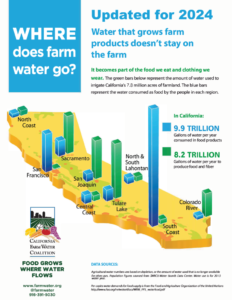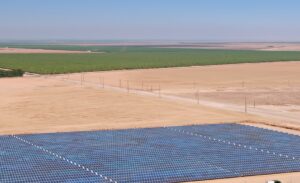Guest Blog: CA water board readopts precedent-setting groundwater regs
Family farmers and ranchers in Siskiyou County in far-northern California will continue to face unprecedented groundwater and surface water curtailments this summer and next if the drought continues. On June 21, the California State Water Resources Control Board readopted a drought emergency regulation for the Scott River and Shasta River watersheds that continues severe curtailments based on new minimum flow requirements in the Scott and Shasta rivers.
Some amendments were made to the existing emergency regulation, which was put in place by the water board last September. According to the Scott Valley Agriculture Water Alliance (AgWA), a local grassroots communication group that formed in response to the emergency regulations, the adopted changes added some flexibility to the previous regulation.
Theodora Johnson, spokesperson for AgWA, said water board staff have been “very willing to talk to us and make fine-tuning changes.” But, she added, the readopted regulation still contains the major aspects that threaten the businesses of the small, multi-generational farms and ranches in the Scott and Shasta valleys.
“The regulation still curtails both groundwater and surface water irrigation if certain flow objectives are not met on either river,” Johnson said. “While the flow objectives for the Shasta got lowered, the Scott River objectives remain unachievably high, setting us up for curtailments. We expect the hammer to drop no later than next month.”
Helping fish?
The regulation is allegedly in response to distressed fish populations. However, as noted by Sari Sommarstrom, a retired watershed consultant from Scott Valley, fish in the Scott River have actually been doing quite well, despite the fact that the water board’s summer flow objectives haven’t been met for the better part of a decade.
Sommarstrom, who commented at the meeting, emphasized the unreasonableness of the regulation.
“As far as I can understand, we’re the only place in California where all ag wells are subject to curtailment, despite Scott Valley not being overdrafted—unlike the San Joaquin and Salinas—despite most ag production wells being addressed in our Scott decree and despite pretty good natural runs of salmon,” Sommarstrom said.
Sommarstrom, a founding member of AgWA, also told the board this spring’s near-record-breaking coho salmon outmigration from the Scott River was not aided by last September’s curtailments—contrary to agency claims.
“Saying the 2020 coho run benefited from these regulations does not match up with the life cycle needs. The regs didn’t kick in until mid-September. It was really last summer—before the regs kicked in—that was the most stressful part for those juvenile rearing coho.”
Communication wins
Sommarstrom noted that the water board staff has been very communicative, but she said, “There’s so much info that we’re not communicating well on, still. The assumption in the regs is that there are fish everywhere, all the time, and that’s not true in the system.”
Johnson and Sommarstrom both noted that one water board member, Vice Chair Dorene D’Adamo, was particularly attentive to AgWA’s concerns.
“We were really grateful for Vice Chair D’Adamo’s addition of a resolution that recognizes our county’s locally-developed Groundwater Sustainability Plan, and the (University of California) Davis-developed hydrologic model that guided that plan,” Sommarstrom said.
“When this emergency reg was adopted last year, it didn’t even recognize the efforts we’ve been making for over a decade to improve our groundwater and flow situation in the Shasta and Scott valleys. We hope the new resolution is a sign that the water board is willing to work with the county and local groups to come up with solutions that are less punitive and more proactive on the supply side of the situation.”
Additional language proposed by D’Adamo did support one supply-side action: “groundwater recharge” permitting.
“That was encouraging to see,” Johnson said. “But the fact remains that the burden is currently being placed 100 percent on our irrigators to reach the flow levels demanded by the water board. We are a snowmelt-dependent system with no dams or big reservoirs. We simply can’t reach those flow levels if we don’t get adequate precipitation. Unless we find ways to hold onto water in the winter and spring when flows are high, we won’t reach the levels they want on the Scott. And the family rancher is the whipping boy.”
Groundwater jurisdiction
An ongoing lawsuit in Shasta Valley is currently challenging the assumption of connectivity between groundwater and surface water in the Big Springs Irrigation District. The water board’s jurisdiction only covers surface water and “interconnected” groundwater.
During the meeting, D’Adamo raised the issue of the water board’s jurisdiction over all groundwater. “I have to say that this is an area that’s troubled me from the start, but I understand the need for us to include groundwater, and I’ve spent a lot of time with our staff really wanting to make sure I understand our authorities and that we are not overreaching.”
She asked a water board attorney at the meeting whether future information obtained regarding connectivity could change the water board’s approach of regulating all the water rights in the Scott and Shasta valleys. The attorney’s response was noncommittal.
Major components of the regulation are the following:
• The 30 percent reduction option: For those wishing to continue irrigating with groundwater after a curtailment is issued, the water board is allowing for individual plans that reduce irrigation by 30 percent. Many ranches have signed up for these plans. However, half of Scott Valley’s irrigated acreage (about 15,000 acres) doesn’t qualify under this type of plan.
• Limited surface water diversions during a curtailment could be allowed. There is a “tributary-wide” plan option that would allow limited surface water use after a curtailment, but this option has not yet been attempted in Scott Valley. It would require coordination between diverters on a given ditch or tributary, coordination with the California Department of Fish and Wildlife, and steady monitoring.
• Livestock watering out of ditches in the nonirrigation season is severely limited, although there are exceptions. AgWA argues that using earthen ditches during the nonirrigation season—in a way that doesn’t harm fish—serves an important function of recharging groundwater and should be encouraged.
• Livestock drinking water is limited during a curtailment. The max allowable use is 15 gallons/day for cattle and 1.5 gallons for sheep. AgWA has consistently argued these amounts are not adequate, especially in hot weather. Water board staff did add language to allow livestock twice the maximum level when temperatures exceed 90 F.
• Penalties of $500 per day for violations are still in place. Some farmers and ranchers have already suffered penalties, in some instances because of accidental misfilings of paperwork.
It’s hard to determine how curtailments and the 30 percent plans will affect Scott Valley this year. In Shasta Valley, several century-old ranches have already gone out of business due to the regulations, and it’s unknown how long the regulations will be in place.
“As long as Gov. (Gavin) Newsom (D) keeps the emergency drought proclamation in place, we’re likely to see readoption of some sort of regulation every year,” Johnson said. “We’re not sure how long many of our historic family farms and ranches can withstand that.” — Scott Valley Ag riculture Water Alliance for WLJ





